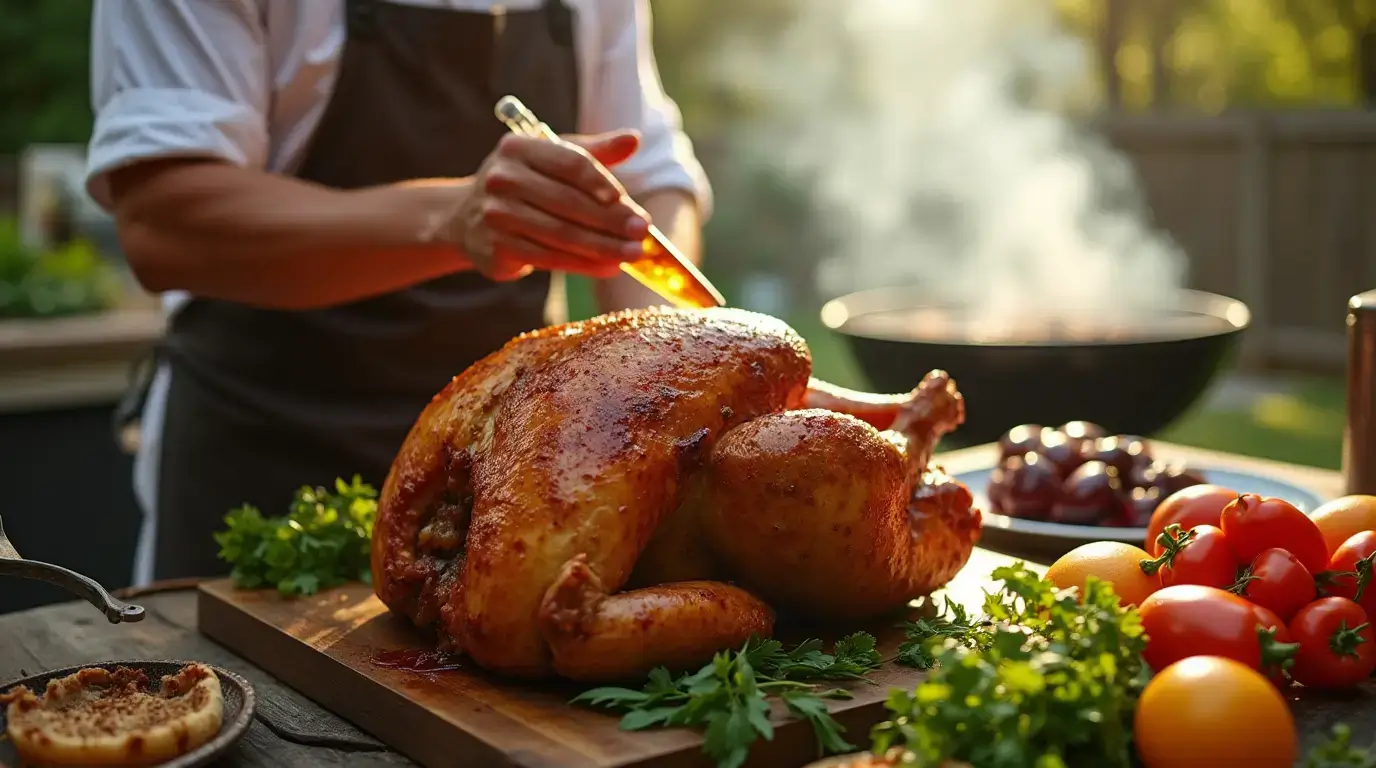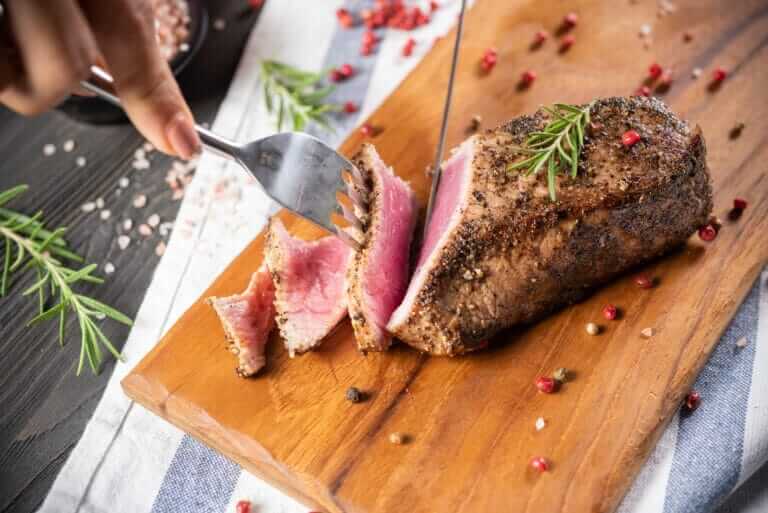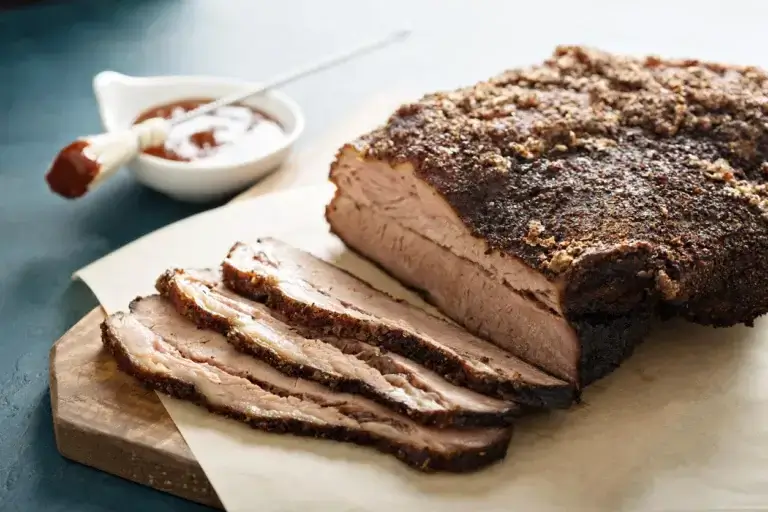Best Marinades for Injecting Turkey for Maximum Flavor
Table of Contents
Imagine spending hours on a turkey for the holidays, only to find it dry and tasteless. That’s where injecting turkey marinade comes in. By injecting turkey marinade into the meat, you’re not just seasoning. You’re turning it into a flavor explosion.
Think of your turkey filled with herbs, citrus, or smoky heat from start to finish. This method makes every bite juicy and full of flavor, whether it’s roasted or fried. Let’s explore how inject into turkey makes ordinary birds into something truly special.
Marinades for Injecting Turkey
Key Takeaways
- Injecting delivers flavor deep into the meat, unlike surface-only marinades.
- Quick injections save time without sacrificing taste.
- Works perfectly for both roasted and fried turkey dishes.
- Safely enhance moisture and avoid dryness with proper technique.
- Choose from sweet, spicy, or herb-infused marinades to match your taste.
Why Injection Is the Secret to Juicy, Flavorful Turkey
Traditional turkey cooking often results in dry meat, especially the breast. By injecting into turkey, you solve this problem. This method fills the meat with tender, flavorful liquids. These liquids create pockets of moisture that stay inside as it cooks.
This technique is especially helpful for big turkeys. Heat can dry out the meat, but injection keeps it moist.
Injected Turkey with Syringe
Science supports this method. Unlike surface marinades, injecting flavors directly into the meat. The injected turkey stays flavorful from the inside out. This avoids over-seasoned skin and bland centers.
Imagine biting into meat that’s juicy and tasty in every slice. That’s the magic of injection.
Here’s why it beats other methods:
- Moisture stays trapped, preventing dryness
- Flavors blend naturally without overpowering surfaces
- Works perfectly for smoking or frying, where drying is common
Chefs and home cooks use this technique for a memorable turkey. Whether you’re smoking it low and slow or frying for crispy skin, injection keeps the inside as good as the outside.
The Benefits of Using Marinades for Injecting Turkey
Ever wonder how chefs make turkey so juicy? Injecting turkey marinade adds moisture and flavor deep inside. This makes your injected turkey a hit. It’s more flavorful and tender than usual.
Enhanced Moisture Throughout the Meat
Injecting marinade into turkey creates pockets of moisture. This is great for turkey breasts, which can dry out. Your injected turkey stays juicy all the way through.
Better Flavor Distribution Than Surface Marinades
Surface marinades only cover the outside. But injecting marinade gets flavors deep into the meat. This means every slice is full of flavor, even near the bone.
Time-Saving Compared to Traditional Marinating
| Method | Time Needed | Flavor Reach |
|---|---|---|
| Traditional Marinating | 24–48 hours | Surface only |
| Injection Method | 10–15 mins | Deep into the meat |
See the difference? Injecting turkey marinade saves time and boosts flavor. No more waiting days for results!
Perfect for Both Roasted and Fried Turkey Preparations
Want to fry a turkey? The injection protects the meat from high heat, keeping it tender. For roasting, add basting for extra flavor. This method works well for all cooking styles.
Essential Equipment for Injecting Your Turkey
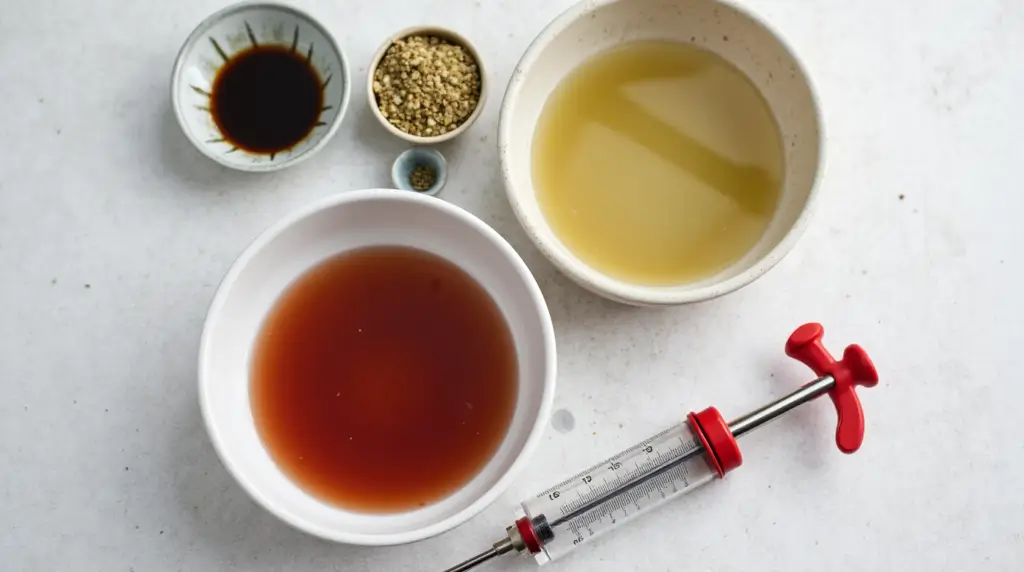
To make perfect turkey marinade, you need the right tools. Start with a good meat injector. Choose stainless steel ones with different needles. You’ll need a thin needle for thin marinades and a thick one for herbs.
Basic injectors start at $15. But, spend $30–$50 for a better model that lasts longer.
- Injector: Pick from basic or premium models with comfortable grips.
- Cutting Board: A big board is great for prepping and injecting the turkey safely.
- Measuring Cups: Important for mixing the right amounts in your marinade.
- Containers: Use airtight jars to store leftover marinade for later.
- Kitchen Twine: Use 100% cotton twine to tie the turkey after injecting.
- Thermometer: A digital thermometer checks the turkey’s internal temperature to 165°F.
- Cleaning Supplies: Use pipe cleaners to clean the injector needles after each use.
Keeping things clean is crucial. Disinfect all tools before and after injecting. Invest in durable tools to make your marinade process easier. Keep your injector needles sharp and clean to avoid damaging the meat.
Step-by-Step Guide: How to Properly Inject Your Turkey
Learning to inject turkey marinade makes every bite full of flavor. Follow these steps to get a juicy, flavorful turkey. Start by preparing your turkey right to soak up more flavor and avoid mess.
Preparing Your Turkey for Injection
Make sure your turkey is thawed and at room temperature. Dry it to keep it steady during injection. Have a clean area ready with your injector, marinade, and a container for drips. Place the turkey on a stable surface like a cutting board or tray. Make sure your injector’s plunger is clean and ready with marinade.
Choosing the Right Injection Sites
Focus on the breast, thighs, and drumsticks. Divide each breast into four parts, injecting one part in each section. Insert the needle parallel to the muscle fibers. For thighs and drumsticks, angle the needle slightly downward to reach deeper layers. Avoid bones by angling around them if you feel resistance.
Proper Technique to Avoid “Leakage”
- Insert the needle at a 45-degree angle to reduce exit points.
- Press slowly, holding the injector steady until the plunger stops.
- Press gently on the injection site post-use to seal the puncture.
- Work quickly but carefully to prevent excess marinade from escaping.
How Much Marinade to Use per Pound
Use ½ ounce of injecting turkey marinade per pound. For a 12-pound turkey, this equals 6 ounces. Put 60% of the marinade in the breast and 40% in the dark meat. Check if your turkey injection marinade recipe is salty—adjust if needed. Add 25% extra marinade to account for absorption loss.
Popular Flavor Profiles for Turkey Injection Marinades
Exploring how to make turkey injection marinade opens up a world of flavors. You can go for classic tastes or try something new. Here are four ways to inject into turkey for amazing results.
Herb and Butter Based Injections
Melted butter is the base for this favorite. Mix in fresh herbs like sage, thyme, and rosemary. Add garlic, lemon juice, and kosher salt for extra flavor.
This fried turkey seasoning injection recipe also adds bourbon and parsley for a smoky flavor. The butter keeps the turkey moist, perfect for roasting.
Savory Broth Injections
- Reduce low-sodium broth by one-third for concentrated flavor.
- Infuse with aromatics like bay leaves and peppercorns before straining.
- Add gelatin for better meat absorption and easy flow through injectors.
These are great with pasture-raised turkeys. They enhance the turkey’s natural taste without being too strong.
Sweet and Tangy Options
Mix apple cider, citrus juices, and warm spices like cinnamon. A turkey injection marinade example is ½ cup apple juice, ¼ cup orange juice, 2 tbsp honey, and a pinch of nutmeg. This mix balances sweet and tangy, making the turkey roast or fry better.
Spicy Cajun-Style Injections
For a bold taste, blend melted butter with hot sauce, Worcestershire, and Cajun spices. Add cayenne, paprika, and file powder for that Cajun kick. This fried turkey seasoning injection recipe is perfect for deep-fried turkeys, especially with cornbread stuffing and collard greens.
Choose your flavor carefully and chill the marinade before using. Adjust the spices to fit your taste. Now, you’re all set to make your injected turkey a hit!
Homemade Fried Turkey Seasoning Injection Recipes
Try these homemade fried turkey seasoning injection recipes to make your turkey extra tasty. These easy mixes make sure the meat is full of flavor. Here are four recipes to impress your guests.
Classic Butter and Garlic Injection
Start with this simple yet delicious option:
- 1 cup melted butter (cooled slightly)
- 2 tbsp minced garlic or 1 tsp garlic powder
- 2 tbsp fresh herbs (thyme, rosemary, sage) or 2 tsp dried
- 1 tbsp kosher salt, 1 tsp white pepper
- 1 tbsp lemon juice + zest, 1 tbsp Worcestershire sauce
Combine ingredients, strain if needed, and keep warm. Inject into turkey, spacing needles 2 inches apart.
Zesty Citrus and Herb Injection
For a fresh twist, blend these ingredients:
- ½ cup OJ + ¼ cup lemon juice
- ¼ cup olive oil, 1 tbsp each minced rosemary, thyme, parsley
- 2 tsp orange zest + 1 tsp lemon zest
- 1 tbsp honey, ½ tsp crushed red pepper
- 1 tbsp salt, 1 tsp pepper, 2 minced garlic cloves
Whisk all ingredients; adjust thickness if needed. Inject into turkey, ensuring even coverage before frying.
Bold Cajun Kick Injection
Bring southern flair with this spicy blend:
- 1 cup melted butter
- 2 tbsp Worcestershire, 1 tbsp Crystal hot sauce
- 1 tbsp Zatarain’s liquid crab boil
- 1 tbsp paprika, 2 tsp garlic powder, 2 tsp onion powder
- 1 tsp thyme, oregano, ½-1 tsp cayenne
- 1 tsp black pepper, 1 tbsp salt, 2 tbsp beer
Combine and strain if clumps form. Inject into turkey, then fry for a crispy crust with bold flavor.
Sweet and Savory Apple Cider Injection
For autumn feasts, try this autumn-inspired mix:
- ½ cup reduced apple cider (simmered until thickened)
- ¼ cup melted butter, 2 tbsp maple syrup (Grade B)
- 1 tbsp Dijon mustard, ¼ tsp cinnamon, ⅛ tsp cloves
- 1 tbsp apple cider vinegar, 1 tbsp soy sauce, 1 tsp thyme
- 1 tbsp salt, ½ tsp pepper
Whisk all, strain if needed, and inject into turkey before frying.
These injected turkey recipes are great with sides like collard greens or sweet potatoes. Adjust the spice to your liking and always strain the mix to avoid clogging your injector. Have fun trying these fried turkey seasoning injection recipes to find your favorite!
Common Mistakes to Avoid When Injecting Turkey Marinade
Perfect injected turkey starts with avoiding these common errors. Even seasoned cooks slip up—here’s how to stay on track:
- Strain First: Unfiltered herbs or solids block injectors. Strain all ingredients before loading your syringe.
- Spacing Matters: Overload a single spot and your turkey leaks juices. Space injections 2-3 inches apart for even absorption.
- Temperature Balance: Too cold? Fats clump. Too hot? Meat cooks prematurely. Aim for 70°F (21°C) for smooth flow.
- Deep vs. Shallow: Shallow injections only flavor the surface. Push the needle 1-2 inches into the muscle for deep penetration.
- Flavor Intensity: Double standard seasoning ratios. The marinade spreads thin, so amp up salt, herbs, and acids.
- Dry Skin First: Moisture traps steam. Pat skin dry post-injection for crispy results.
Small adjustments make a big difference. By steering clear of these traps, your injected turkey becomes a crowd-pleaser every time.
Timing It Right: When to Inject Your Turkey Before Cooking
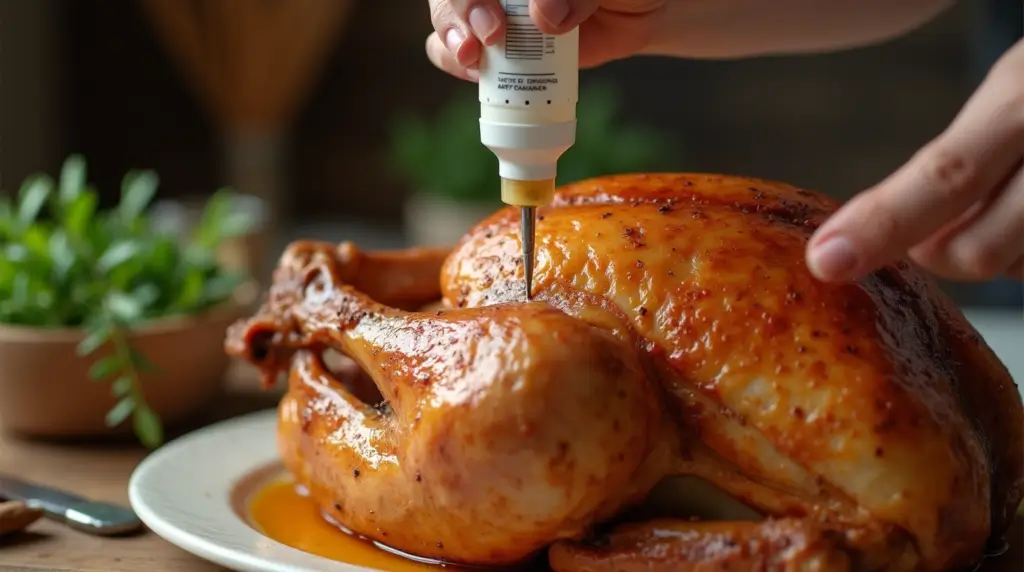
For the best taste, inject your turkey 12–24 hours before cooking. This allows the flavors to soak deep into the meat. If you’re short on time, 2–4 hours still makes a big difference. Here’s what to do:
| Timeframe | Purpose | Best Practices |
|---|---|---|
| 12–24 hours | Full flavor diffusion | Refrigerate covered; ideal for roasting or frying |
| 8–12 hours | Fried turkey prep | Avoid over-marination; check meat texture |
| 2–4 hours | Quick flavor boost | Inject thicker parts first |
| 0 hours (immediate) | Emergency cooking | Focus injections on the thickest areas |
Never inject a turkey that’s not fully thawed. Thaw it fully in the fridge first. Large turkeys might need 24+ hours. After injecting, let your injected turkey sit at room temperature for 30–60 minutes before cooking. Always follow food safety rules!
Don’t leave your turkey out for more than 2 hours. Acidic or alcohol-based marinades can “cook” the meat if left too long. For longer storage, keep it to 36 hours max. Adjust your schedule to match these guidelines for perfect results every time.
Storage and Food Safety When Using Injected Turkey Marinades
When injecting turkey marinade, keeping food safe is key. Right storage and handling prevent harmful bacteria. Follow these steps to keep your injected turkey safe and tasty.
Proper Handling of Raw Injected Turkey
Always clean surfaces and hands before starting. Use separate tools for injecting turkey and other tasks. Never reuse marinade that’s touched raw meat. After injecting, refrigerate the turkey right away. Here’s how to stay safe:
- Wash hands with soap for 20 seconds after handling raw poultry.
- Sanitize your injector with hot, soapy water after each use.
- Keep raw injected turkey on the lowest fridge shelf to prevent drips.
How Long Can You Store an Injected Turkey?
Refrigerate your injected turkey for up to 36 hours before cooking. For longer storage, freeze it tightly wrapped—up to 3 months. Thaw in the fridge, not at room temperature. After thawing, cook within 24 hours.
Safe Internal Temperature for Injected Turkey
Always use a digital thermometer. The USDA requires 165°F (74°C) for poultry. For fried turkey seasoning injection dishes, remove from the fryer at 157-160°F; carryover heat will finish cooking. Check multiple spots:
- Thigh: Insert thermometer near the joint but not touching bone.
- Breast: Aim for the thickest part.
- Wing: Ensure it reaches 165°F.
Let fried turkeys rest 15-20 minutes post-cook to even out heat.
Conclusion: Elevate Your Turkey Game with Perfect Injection Techniques
Injecting turkey marinade is more than just a step in cooking. It’s a way to add juicy, bold flavors that make your turkey stand out. Every injection adds moisture to the meat, turning a simple turkey into a showstopper for any occasion.
Feel free to mix injection with dry rubs or brines for even more flavor. Begin with a basic recipe and then adjust it to fit your taste. Even small changes in the marinade or where you inject can make a big difference. As you get better, your turkey will impress everyone.
Next time you host, let your injected turkey be the star. It will be so tender and rich that your guests will wonder how you did it. Now’s the time to grab that injector and elevate your cooking to new heights.
FAQ
What is the best liquid to inject into turkey for flavor?
You can use many liquids for injecting turkey. Try herb-infused butter, broth, or citrus juice marinades. Each adds moisture and flavor, so pick what you like best.
How do I make a turkey injection marinade?
Mix melted butter or broth with herbs, spices, and citrus or sweeteners. Strain it to avoid clogs. Adjust the taste to your liking.
Can I inject turkey the night before cooking?
Yes, injecting turkey 12-24 hours before cooking is great. Keep it in the fridge to stay safe and flavorful.
How much marinade do I need to inject into my turkey?
Use about ½ ounce of marinade per pound of turkey. That’s roughly 1 tablespoon for each pound. Adjust based on the marinade’s strength and turkey size.
Are there any mistakes to avoid when injecting turkey?
Yes, avoid injecting too much in one spot and using chunky ingredients. Also, don’t inject when the marinade is too cold or hot. Keep it room temperature and spread it evenly.
What is the ideal temperature for the injected turkey?
The USDA says turkey should be 165°F (74°C) inside. Use a meat thermometer to check the thickest parts.
How should I handle the turkey after injecting?
After injecting, cover and refrigerate the turkey until cooking. Wash your hands and surfaces to avoid contamination.
Can I freeze an injected turkey?
Yes, you can freeze an injected turkey. Do it within 36 hours for best results. Wrap it tightly and cook within three months.
What’s a good fried turkey seasoning injection recipe?
Try melted unsalted butter, minced garlic, chopped herbs, kosher salt, and pepper. Mix well and strain to avoid clogs for a tasty fried turkey.
Leave a Review
There are no reviews yet. Be the first one to write one.

